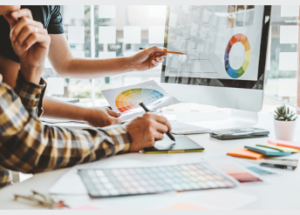ICON graphic design Adelaide uses images, text, and other visual elements to convey ideas or messages. It encompasses everything from a company’s logo to television ads.
 Graphic design is an ever-evolving field that expands as new technologies emerge. The elements and principles of graphic design can be employed to convey specific messages, build brand identity, attract target audiences, and improve usability.
Graphic design is an ever-evolving field that expands as new technologies emerge. The elements and principles of graphic design can be employed to convey specific messages, build brand identity, attract target audiences, and improve usability.
Alignment
Alignment is a vital design principle that gives your logo, and other designs a more organised appearance, making them easier to read and comprehend.
Graphic designers use alignment to give their elements a professional appearance, from text to images and icons. This simple trick can make your designs stand out from competitors and give them an expert touch.
Edge alignment is the most commonly used type to position elements against a canvas or page’s edge. This style of a logo, especially those with text, often utilises this technique for positioning elements correctly.
A less common alignment option is flush right, which places text hard on the right-hand margin with a soft, uneven left side. This style is often employed in logos and other designs with text but can also be applied to smaller elements.
Another type of alignment is optical, which positions elements to appear aligned to the eye. It can be effective when your items are all on one layer or page, but it’s not as precise as metrical alignment.
Repetition
Repetition is an essential ICON graphic design Adelaide principle that unites, emphasises and strengthens a graphic piece. It can also help establish consistency and hierarchy within the work.
Graphic designers often repeat elements throughout work to establish branding, create comfort and increase familiarity with their audience. It can also draw attention to specific areas of the design while adding texture and interest.
One common type of repetition is using the same colour palette across a design to make it easy for consumers to recognise and connect with specific products or brands.
Another type of repetition involves repeating certain shapes or motifs. An example would be using the same style font across all pages or product sections on a company website, allowing users to quickly identify different sections without rediscovering them each time they visit another page.
Repetition can reinforce messages and teach customers how to utilise an app or website. For example, if customers need to click on a CTA button multiple times throughout a page, they are more likely to remember the message and follow its instructions.
Similar to how logos appear across multiple pages of a website or app, consumers will be more likely to associate the design with the brand and be more inclined to buy from or visit the site again.
Proximity
Proximity is an influential design principle that encourages users to group items and arrange them logically on your page. It makes it simpler for viewers to comprehend the information on your page and navigate through it more efficiently.
Designing with proximity can be a powerful tool for improving messaging, especially when conveying specific information or ideas. By utilising proximity, you can highlight different elements of your message and focus on the essential parts of your design.
You can use proximity to create hierarchy within your design, placing certain items in a distinct order and distinguishing them from other parts of your message. It helps readers comprehend the proper order to look at the information on your page, which is especially beneficial when creating designs that need to be viewed over time.
For example, when writing a blog post about an animal, the top priority should be given to mammals since they are the closest relatives to humans. Reptiles would then follow, followed by birds and fish.
When designing a business card, proximity can be used to conveniently share contact information and showcase the aesthetic of your product or service. It helps readers comprehend the purpose of your enterprise and makes it simpler for them to contact you if they have any queries or issues.
Regarding proximity, it’s best to use the principle only when your design is carefully thought out and organised. It isn’t essential for every design you create and may even be best avoided when conveying complex ideas or information.